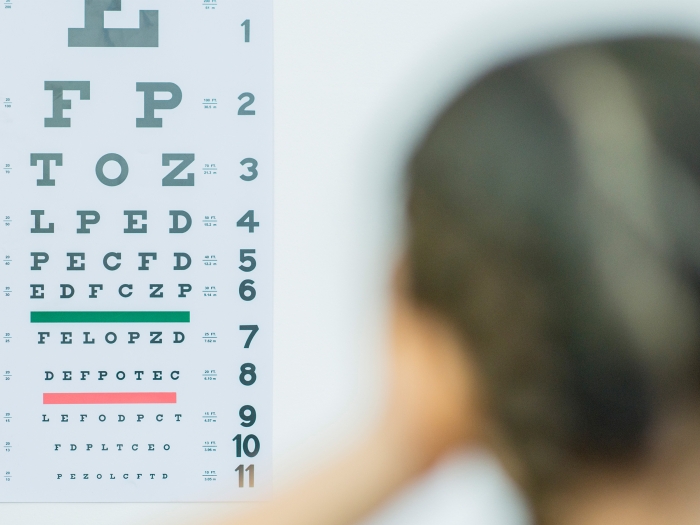One of the lesser-known consequences of osteogenesis imperfecta – brittle bone disease – is an increased risk of eye diseases like glaucoma. Patients of all ages should receive annual ophthalmic screenings.
8:01 AM
Author |

Osteogenesis imperfecta (OI), also known as brittle bone disease, affects about one in 15,000 people. OI almost always results from a mutation in one of two genes that drive the production of collagen, a building block of connective tissue.
In addition to making bones more breakable, OI is also linked with breathing, hearing, dental and cardiovascular problems.
LISTEN UP: Add the new Michigan Medicine News Break to your Alexa-enabled device, or subscribe to our daily audio updates on iTunes, Google Play and Stitcher.
While OI patients, families and providers have come to expect those potential challenges, it is only within the last decade that OI has been linked to ophthalmic diseases, notably an increased risk of glaucoma.
Recent Michigan Medicine research, appearing in the Journal of the American Association for Pediatric Ophthalmology and Strabismus, focuses on how collagen defects present in patients with OI also alter the cornea.
"We've known anecdotally for some time that glaucoma in OI patients tends to be an earlier-onset, more severe form of the disease," says Brenda Bohnsack, M.D., Ph.D, assistant professor of ophthalmology and visual sciences at the Kellogg Eye Center and a pediatric glaucoma specialist.
"We wanted to learn about the factors that predispose a patient with OI to develop glaucoma earlier in life."
In particular, Bohnsack's team focused on how the defects in collagen-related genes associated with OI impact the biomechanical properties and function of the cornea in children with OI.
This study confirmed what we expected: that the collagen defect inherent in OI fundamentally alters the structure and biomechanics of the cornea.Brenda Bohnsack, M.D., Ph.D,
About the Study
The team conducted comprehensive ophthalmic examinations of both children with OI and healthy children, ages six through 19. The testing included measuring intraocular pressure (IOP), central corneal thickness (CCT), corneal resistance factor (CRF), corneal hysteresis (CH) and ultrasound pachymetry.
"This study confirmed what we expected," continues Bohnsack, "that the collagen defect inherent in OI fundamentally alters the structure and biomechanics of the cornea."
OI patients had decreased rates of CH and CRF, thinner CCT measurements, and higher corneal-compensated IOP, compared with the control group.
Key Findings
"Both a thinner cornea and a lower level of CH are risk factors for glaucoma," explains Bohnsack. "We were able to identify these corneal changes in even the youngest OI patients we examined. That reinforces the importance of starting ophthalmic screening soon after OI diagnosis, to catch glaucoma early.
"Early diagnosis of glaucoma – regardless of the cause – is key for maintaining vision," Bohnsack continues. "One of the biggest challenges in treating this form of glaucoma is that in its early stages, patients have few if any symptoms. There is no pain, and if there is vision loss, it begins in the periphery. It's only at a later stage that glaucoma impacts the central vision.
MORE FROM MICHIGAN: Sign up for our weekly newsletter
Bohnsack recommends that OI patients be screened at least once a year for ocular diseases, especially glaucoma.
"While this study reinforces the importance of screening young OI patients, the recommendation applies to patients of all ages," she said. "Many of our pediatric OI patients also have adult family members with OI, who may not be aware of their increased risk of diseases like glaucoma."
Findings such as these underscore the importance of Michigan Medicine's monthly Osteogenesis Imperfecta Multidisciplinary Clinic, managed through the hospital's pediatric orthopaedics program. Over two consecutive days, appointments can be coordinated across the health system with specialists in orthopaedics, genetics, otolaryngology, dentistry, audiology and ophthalmology. As a relatively high-volume center for this rare disease, Michigan Medicine is able to offer patients this more comprehensive, convenient approach to care.
"We're thrilled that ophthalmology is integrated into the clinic," says Bohnsack. "It raises awareness of the vision-related risks of OI, it reinforces the importance of regular screening, and it makes important research like this possible."
To consult with a specialist in osteogenesis imperfecta or refer a patient to the OI Multidisciplinary Clinic, contact M-Line at 800-962-3555. Patients may contact the Pediatric Orthopaedics Clinic at 734-936-5780.

Explore a variety of healthcare news & stories by visiting the Health Lab home page for more articles.

Department of Communication at Michigan Medicine
Want top health & research news weekly? Sign up for Health Lab’s newsletters today!





